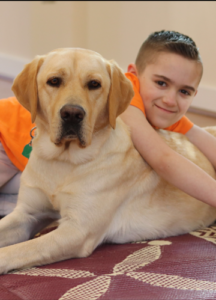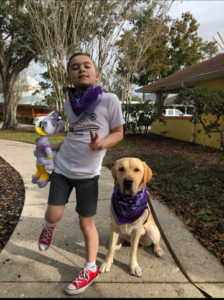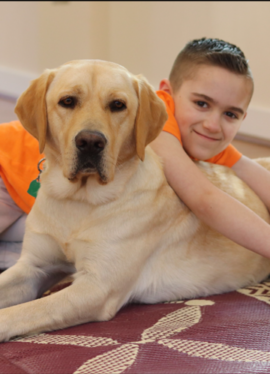Barton to the Rescue
Dogs are often referred to as people’s best friend. But what if they did more than that? What if a dog could alert you before something drastically changes? Well, for Anita and her son Ryan, a service dog was just what they needed. Anita and Ryan were originally from Virginia. They ended up moving to North Carolina because the University of Virginia Medical Center, also known as UVA, couldn’t help with Ryan’s condition – Dravet Syndrome.
The doctors at UVA gave Ryan five years to live. Anita was not just going to sit back and be content with what they said. So she did research and found a place in North Carolina that could help treat Ryan. She got Ryan in at Duke Children’s Hospital and Health Center.
After she got to North Carolina, Anita tried going to local support groups. She did this to find other parents who are fighting for their children’s lives. A couple of the families at the local support groups had service dogs. Anita said, “I was skeptical at first. I really didn’t know much about them. However, that’s when my research began.” With the research she did, she found EENP, which stands for Eyes Ears Nose & Paws.
Anita reached out to EENP and got a meeting with them. At the very first meeting, multiple service dogs came over, alerting to Ryan, because they knew he would have a seizure within the hour. At that moment, Anita realized she had to get a service dog for her son. After years of saving and with the help of CDK with scholarships and pairing Anita with EENP, she had enough money to get Ryan a medical alert dog. That was when Barton came into their lives. Anita and Ryan went into training in October 2019 and paired with Barton almost immediately. They graduated from their training with Barton on November 4, 2019.
Barton has been a lifesaver. Barton alerts Anita to body temperature changes within Ryan. Ryan has 15 to 20 seizures a day and Barton alerts Anita 30 to 45 minutes before each seizure Ryan has, regardless of the severity. This warning allows Anita time to get the emergency meds in place and start preparing for what’s about to happen. “I think having Barton has given Ryan a sense of peace. He is less scared and knows his furry angel is always by his side.” Anita also feels more relieved because she can now leave Ryan’s side without continually worrying about him. Ryan is 10 years old now, so he has already outlived his prognosis by five years and Barton has been a big help.
Keeping Ryan alive has been an uphill battle since day one. A typical day for Ryan starts at 5 in the morning. This is when Ryan starts taking his meds. He takes meds at 5 a.m., 6 a.m., 7 a.m. and 7:45 a.m. He takes meds 10 times a day. Anita has a schedule set up for when he takes his meds. That way he gets some breaks in between taking them. After all the meds in the morning Ryan typically takes a nap until 9 a.m., because the meds make Ryan tired.
Ryan does his school work from home because of his seizures and his compromised immune system. Ryan takes three classes virtually. Ryan can’t read or write, but he is really good at video games. Ryan’s favorite video games are Roblox, Super Smash Bros, Minecraft, and Among Us. He starts taking the rest of his 10 meds a day at 5 p.m. and goes all the way through 9 p.m.
Anita definitely recommends getting a service dog if people are thinking about it because it can really save their child’s life. Without Barton, Anita lived in constant fear because she had no idea when a seizure was about to hit. She went on to explain, “It never gets easier being the parent of a disabled child with a life-threatening illness. But with a service dog to help and warn you, it becomes more manageable.”
- Bailey Corley
Bailey is a Professional Communication and Journalism student at University of Maine, Presque Isle (2020)













